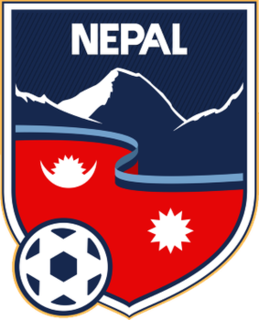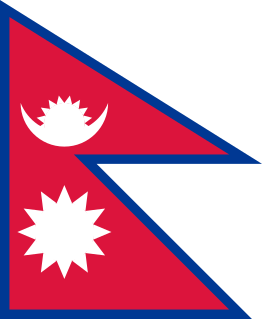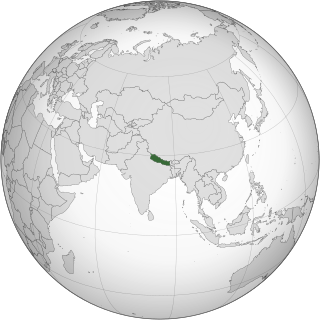
The Lhotshampa or Lhotsampa people are a heterogeneous Bhutanese people of Nepalese descent. The Lhotshampa people are native to southern Bhutan, and are thus colloquially referred to as Southerners. Starting in 2007, most of the Lhotshampas, or Bhutanese Refugees, were resettled to third countries, such as the United States, Canada, Australia, the United Kingdom, and other European countries. Today, the number of Lhotshampa in Nepal are significantly lower than that in the United States and other countries where they were resettled. The people of Nepalese origin started to settle in uninhabited areas of southern Bhutan in 19th century.

Nepal, officially the Federal Democratic Republic of Nepal, is a landlocked country in South Asia. It is located mainly in the Himalayas, but also includes parts of the Indo-Gangetic Plain. With an estimated population of 26.4 million, it is 48th largest country by population; it is the 93rd largest country by area. It borders China in the north and India in the south, east and west while Bangladesh is located within only 27 km (17 mi) of its southeastern tip and Bhutan is separated from it by the Indian state of Sikkim. Nepal has a diverse geography, including fertile plains, subalpine forested hills, and eight of the world's ten tallest mountains, including Mount Everest, the highest point on Earth. Kathmandu is the capital and the largest city. Nepal is a multiethnic country with Nepali as the official language.
The Nepalese rupee is the official currency of the Federal Democratic Republic of Nepal. The Nepalese rupee is subdivided into 100 paisa. The issuance of the currency is controlled by the Nepal Rastra Bank, the central bank of Nepal. The Nepalese rupee was introduced in 1932, when it replaced the Nepalese mohar at the rate 2:1.

Biratnagar is the fifth largest city and the capital to Province No. 1 of Nepal. It has a population of 242,548 per the 2011 census. Gifting a subtotal of five prime ministers alongside hosting a number of revolutionary incidents

The Nepal national football team represents Nepal in international men's football and is governed by the All Nepal Football Association (ANFA). A member of the Asian Football Confederation (AFC), the Nepalese football team play their home games at Dasarath Rangasala Stadium, Tripureswhor, Kathmandu.

Hinduism is the main and largest religion of Nepal. The Constitution of Nepal have established a call for protection of old aged religion i.e Hinduism through out the country and this state that Hinduism is the Official religion of Nepal which get special privileges in the Constitution. In the 2011 Nepal census, approximately 85 percent of the Nepalese people identified themselves as Hindus including Kirati ethnic indigenous religion which is also considered as sect or a branch of Hinduism, although observers note that many of the people regarded as Hindus in the 1981 census could, with as much justification, be called Buddhists. According to 2011 census, the Hindu population in Nepal is estimated to be around 22,493,649 which accounts 85% of country's population. The national calendar of Nepal, Vikram Samvat, is a solar Hindu calendar essentially the same to that widespread in North India as a religious calendar, and is based on Hindu units of time.
Nepal Standard Time (NPT) is the time zone for Nepal. With a time offset from Coordinated Universal Time (UTC) of UTC+05:45 all over Nepal, it is one of only three time zones with a 45-minute offset from UTC.

Nepalis are citizens of the Federal Democratic Republic of Nepal under the provisions of Nepali nationality law. The country is home to people of many different national and ethnic origins. As a result, people of Nepal do not equate their nationality with ethnicity, but with citizenship and allegiance. Although citizens make up the majority of Nepali, non-citizen residents, dual citizen and expatriates may also claim a Nepali identity.

Christianity is, according to the 2011 census, the fifth most practiced religion in Nepal, with 375,699 adherents, or 1.4% of the population. However, it is widely claimed that non-Hindus are systematically under-reported in Nepal's censuses, and informed observers have estimated that there are at least 1 million Nepali Christians. According to a report by Gordon Conwell Theological Seminary, Nepal's church is the fastest growing in the world. The vast majority of Nepali Christians are evangelical Protestants ; there is also a small Catholic population of roughly 10,000.

Lesbian, gay, bisexual and transgender (LGBT) rights in Nepal are among the most progressive in Asia. The Nepalese Constitution recognizes LGBT rights as fundamental rights.
Same-sex marriage is not recognized or performed in Nepal. In 2011 and 2012, as the country was undergoing a political transition, there was an attempt to add LGBT-inclusive language to the proposed Constitution. However, negotiations among political factions failed in the spring of 2012 and the drafting of a new constitution was placed on hold until new elections were held.
Shailaja Acharya was a Nepali revolutionary, politician and diplomat. She was the first Nepali woman Minister of Water Resources, and the first Nepali woman deputy prime minister.

Bahun or Khas Brahmin(Nepali: खस ब्राह्मण) or Nepali Brahman is a caste(Varna) among Khas people, whose origins are from Indo-Aryans of Nepal. According to 2011 Nepal census, Brahman/Bahun stands as second most populous group after Chhetri in Nepal.

The Council of Ministers or Federal Executive exercises authority over the Federal Government of Nepal. The Prime Minister is the head of the Council of Ministers. The incumbent Prime Minister is Khadga Prasad Oli.
Sushma Karki is Nepalese glamour model and film actress, known for her works in Kollywood. She began her acting career with the Nepali film Mero Euta Saathi Cha.

The Chief of Army Staff (COAS), informally known as Chief Sa'ab, is a military appointment and statutory office held by the four-star rank army general in the Nepalese Army, who is appointed by the President of Nepal on the recommendation of Council of Ministers of Nepal. The Chief of Army Staff is the commander and head of the Nepalese Army.
Communism in Nepal traces its roots back to the pro-democracy movement of 1951, and the subsequent overthrow of the autocratic Rana regime and the establishment of democracy in Nepal. The communist movement in Nepal has split into factions multiple times and multiple factions have come together into a single fold at times as well. It has a history of getting banned from open political discourse; as well as multiple instances of embracing guerrilla insurgency, most notably, the Maoist insurgency in the 1990s and early 2000s that led to the Nepalese civil war, claiming at least 15,000 lives. After the Maoists and other main political parties formed a united coalition, launching a successful peaceful civil resistance against the dictatorial coup d'état by the monarchy, which resulted in the abolition of monarchy and drafting of a new constitution affirming Nepal as a secular, federal, democratic republic striving towards democratic socialism, the two main communist parties of Nepal contested the first election according to the new constitution as a coalition, eventually leading to the unification of two parties with a strong majority in the federal parliament as well as six out of seven provinces of Nepal.
Photo Kathmandu is a biennial international photography festival held in Patan, Nepal, and organised by photo.circle, a Kathmandu based cultural organisation, and Shikshya Foundation Nepal.

The global COVID-19 coronavirus pandemic was confirmed to have spread to Nepal when its first case was confirmed in Kathmandu on 24 January 2020. The patient only showed mild symptoms and had been discharged a week earlier with instructions to self-quarantine at home; he was subsequently confirmed to have completely recovered. Between January and March, Nepal took steps to prevent a widespread outbreak of the disease, while preparing for it by procuring essential supplies, equipment and medicine, upgrading health infrastructure, training medical personnel, and spreading public awareness. The second case was confirmed on 23 March 2020. As of 29 March 2020, three additional cases have been confirmed, including one each in Kailali and Baglung districts. All five confirmed cases have been in people who had recently returned from abroad. The four patients under treatment are reported to be in "normal" condition. A country-wide lockdown came into effect on 24 March, and is scheduled to end on 8 April.










